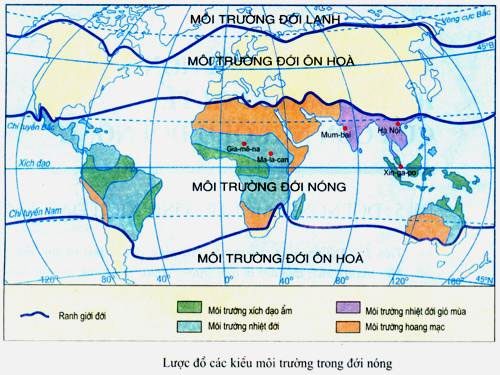On Earth, regions are categorized into three climatic zones: tropical, temperate, and polar. In this article, we will share information about the tropical zone – a region that houses up to 70% of the world’s plant and animal species.
What is the Tropical Zone?
The tropical zone is located between the two tropics, extending from west to east, forming a belt around the Earth. This area is characterized by high temperatures and the Northeast and Southeast Trade Winds blowing year-round from the subtropical high-pressure belts towards the equator.
The tropical zone covers a significant portion of the Earth’s land area, featuring a rich and diverse array of flora and fauna. Approximately 70% of all plant, bird, and mammal species on Earth inhabit tropical rainforests. This region is also densely populated, hosting many developing countries worldwide.

Types of Environments in the Tropical Zone
The tropical zone encompasses several environmental types: humid equatorial environment, tropical environment, monsoonal tropical environment, and desert environment.
First: Humid Equatorial Environment
The humid equatorial environment is located between 5°N and 5°S latitude.
This environment has a hot and humid climate year-round. The temperature difference between the hottest and coldest months is minimal (around 3°C), but the temperature difference between day and night can exceed 10°C. Annual rainfall averages between 1500mm and 2500mm, with rainfall occurring throughout the year; the closer to the equator, the more rainfall there is. Humidity is also very high, averaging over 80%, resulting in a damp and stifling atmosphere.
The high humidity and temperature create favorable conditions for dense forest growth. The rainforest remains lush year-round, with trees growing in multiple layers reaching heights of 40 to 50 meters. The forest also features various woody vines, orchids, and mistletoe, alongside agile climbing mammals and a diverse array of birds. In estuarine and coastal muddy areas, mangrove forests can be found.
Second: Tropical Environment
The tropical environment refers to regions located between 5° and the tropics in both the Northern and Southern Hemispheres, making it one of the most densely populated areas in the world.
The climate in this environment is characterized by high temperatures year-round and a dry season from March to September. This dry season can extend longer, with greater temperature variations occurring closer to the tropics.
The average annual temperature is approximately 20°C. Despite being hot year-round, there are seasonal variations. The period when the Sun is overhead marks the time of increased temperatures. Annual rainfall ranges from 500mm to 1500mm.
The natural environment of the tropical region changes with the seasons.
During the rainy season, vegetation flourishes, and animals are active, coinciding with the flooding of rivers. In mountainous regions, rainwater seeps deep into the underlying layers of soil and rock.
In the dry season, vegetation wilts, and animals migrate to areas with water sources; river water levels decrease, and riverbeds narrow. In hilly areas, water moves upward carrying iron and aluminum oxides that accumulate near the surface, resulting in reddish-yellow soil known as ferralsol.
Soils in the tropical environment are prone to erosion, leaching, or degradation without proper plant cover and sustainable agricultural practices.
Vegetation gradually transitions towards the two tropics, with sparse forests giving way to tropical grasslands (savanna) and ultimately to areas with sparse grass and some thorny shrubs (semi-desert). The extent of savanna and semi-desert is increasing, not only due to low rainfall but also due to human activities such as deforestation, land clearing for agriculture, or logging. The land is gradually degrading, making it difficult for plants to regrow.
The tropical environment is suitable for cultivating a variety of food crops and industrial plants. In areas with efficient irrigation, agricultural production thrives, leading to dense populations.
Third: Monsoonal Tropical Environment
The monsoonal tropical climate is a distinctive climate of the tropical zone, particularly evident in South Asia and Southeast Asia.
In South Asia and Southeast Asia, during summer, winds blow from the Indian Ocean and Pacific Ocean, bringing cool air and heavy rainfall. In winter, the monsoon winds blow from the Asian continent, bringing dry and cold air. As one moves closer to the equator, the humidity of the winds increases. The winter monsoon comes in bursts. Whenever the winds arrive, temperatures near the tropics drop for a few days, sometimes persisting for weeks. In winter in Hanoi, temperatures can drop below 10°C for several days.
The monsoonal tropical climate is characterized by two prominent features: seasonal variations in temperature and rainfall, and unpredictable weather patterns.
The average annual temperature here is over 20°C, with an average temperature range of about 8°C.
Annual rainfall exceeds 1000mm but varies depending on proximity to the sea, topography, and wind exposure.
Weather patterns can be erratic. In some years, the rainy season starts early, while in others it may start late, and rainfall amounts can vary significantly, leading to droughts or floods.
The monsoonal tropical environment is diverse and rich, with seasonal rhythms impacting both the natural landscape and human life in the region.
Depending on the amount and distribution of rainfall throughout the year, various types of vegetation can be found. The monsoonal tropical climate is particularly suitable for growing tropical food crops (especially rice) and industrial plants. The monsoonal tropical region is one of the most densely populated areas in the world.
Fourth: Desert Environment
Deserts are found in most continents and cover nearly one-third of the Earth’s land surface. The desert environment lies alongside the tropics, deep inland, often adjacent to cold ocean currents.
The desert environment has an extremely dry and harsh climate, with significant temperature differences between day and night and between winter and summer. Due to water scarcity, both flora and fauna are limited.
Population in these areas is concentrated around oases.
To adapt to the environment, plants and animals employ strategies to minimize water loss, enhance water and nutrient storage, and avoid heat.


















































